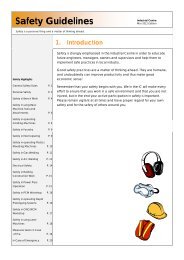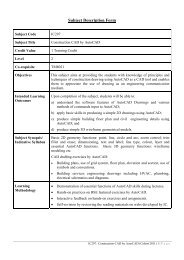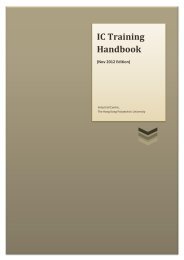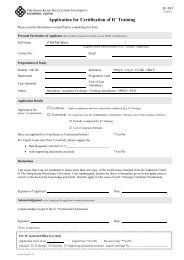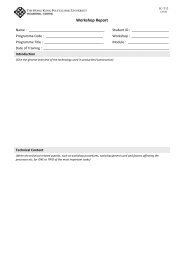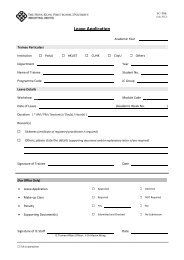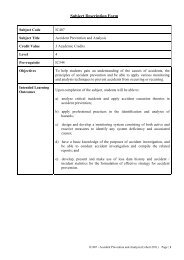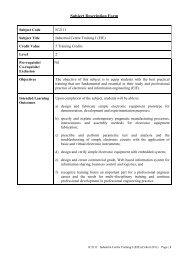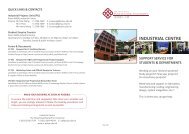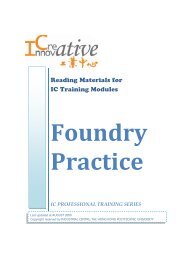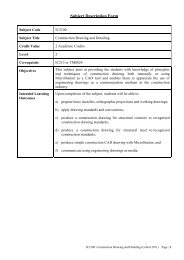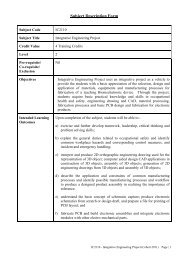IC406-Ergonomics and Human Factors
IC406-Ergonomics and Human Factors
IC406-Ergonomics and Human Factors
Create successful ePaper yourself
Turn your PDF publications into a flip-book with our unique Google optimized e-Paper software.
Subject Synopsis/<br />
Indicative Syllabus<br />
1) Introduction<br />
A brief history of ergonomics <strong>and</strong> human factors including their<br />
definitions. Introduction to common ergonomic hazards <strong>and</strong> illnesses.<br />
Introduction to the principles of ergonomics <strong>and</strong> the areas of<br />
applications.<br />
2) Anatomy <strong>and</strong> Physiology as Applied to Work<br />
Anthropometry: anthropometric data, statistical concepts <strong>and</strong><br />
anthropometric applications. Biomechanics: biomechanical<br />
classification of movements; physiological <strong>and</strong> operational categories of<br />
movement. Anthropometric <strong>and</strong> biomechanical techniques applied to<br />
ergonomic hazard analysis <strong>and</strong> control.<br />
3) Work Physiology <strong>and</strong> Shift Work<br />
Physiological response. Energy <strong>and</strong> energy sources of the body.<br />
Categories of work. Physical work capacity. Fatigue <strong>and</strong> its evaluation.<br />
Classification of workload. Endurance in physical work <strong>and</strong> work-rest<br />
scheduling.<br />
4) <strong>Human</strong> Information Processing<br />
Physiological mechanism in human information processing. Model of<br />
human information processing. Mental workload. Sensation <strong>and</strong><br />
perception. Methods to improve ability of information processing.<br />
Attention. Signal detection.<br />
5) Interaction with the Environment<br />
<strong>Human</strong> senses <strong>and</strong> the physiological mechanisms. Homeostasis.<br />
Acclimatization. Hot <strong>and</strong> cold situations.<br />
6) Work Scheduling<br />
Body rhythms <strong>and</strong> individual differences. Sleep <strong>and</strong> sleep phases. Shift<br />
organization <strong>and</strong> patterns. Effects of shift work on workers. Guidelines<br />
for shift work. Criteria for selection of shift workers. Alternative work<br />
schedules.<br />
7) Design of Repetitive <strong>and</strong> Manual H<strong>and</strong>ling Tasks<br />
Introduction to work-related musculoskeletal disorders. The back <strong>and</strong><br />
neck problems. Cumulative trauma disorders (CTSs) in the upper<br />
extremities. Fundamental risk factors of CTDs. Prevention <strong>and</strong><br />
treatment of CTDs. Anatomy <strong>and</strong> biomechanics of manual h<strong>and</strong>ling.<br />
Prevention of manual h<strong>and</strong>ling injuries in the workplace. Design of<br />
manual h<strong>and</strong>ling tasks. Postural stability <strong>and</strong> postural control. Design of<br />
carrying tasks.<br />
8) Work-tool Design<br />
Grip strength <strong>and</strong> endurance. <strong>Ergonomics</strong> guidelines for h<strong>and</strong>-tool<br />
design. Safety guidelines for tool use. The workplace characteristics <strong>and</strong><br />
the worker’s functions. Design guidelines for controls <strong>and</strong> displays.<br />
9) Workstation Design <strong>and</strong> Office <strong>Ergonomics</strong><br />
Workstation design problems. Principles for workstation design.<br />
Ergonomic guidelines for seated workstations <strong>and</strong> st<strong>and</strong>ing tasks. Office<br />
health problems <strong>and</strong> solutions. Workstation design for office work,<br />
including display screen equipment user.<br />
<strong>IC406</strong> - <strong>Ergonomics</strong> <strong>and</strong> <strong>Human</strong> <strong>Factors</strong> (Cohort 2011) Page | 2



